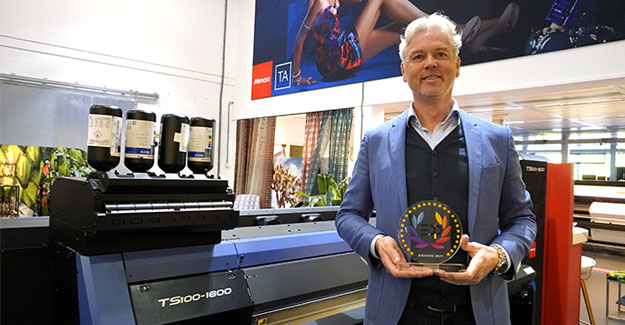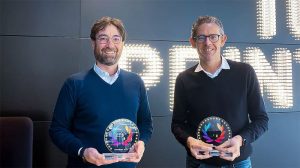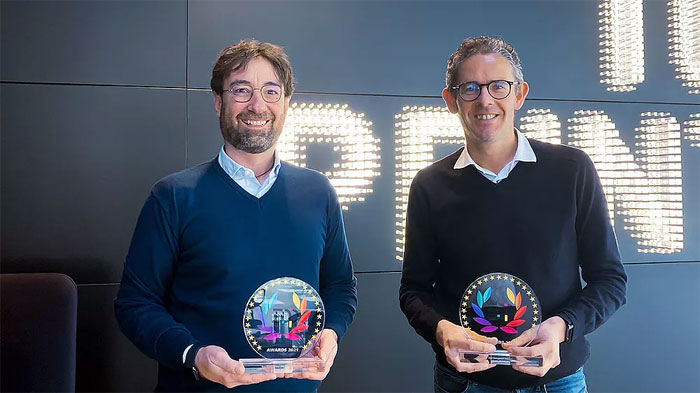
What’s Happening In Textile Digital Printing
Mimaki Engineering Co., Ltd., recently won the EDP Award 2021 for three of its products - JFX600-2513 flatbed/hybrid printer (max. 100 m2/h), TS100-1600 roll-to-roll textile printer (max. 100 m2/h), and 3DUJ-2207 3D additive printing (full-color).
Awarded in the "Roll-to-roll textile printer (max. 100 m2/h) category", the TS100-1600 is an entry model of sublimation transfer inkjet printer that offers a good balance of operational performance, image quality, speed, and cost, and achieves a maximum print speed of 70 m2/h. This model can handle from samples to large lot production. It is capable of printing to dedicated media (transfer paper) to transfer its print to polyester materials with using heat transfer system. Its application is versatile, ranging from banners for indoor and outdoor display, banner flags, to T-shirts and handkerchiefs. Furthermore, the DAS (Dot Adjustment System) function, which automates dot position and feed rate compensation, and the use of ECO PASSPORT certified ink make this product ideal solution considering the operator's work environment.
The EDP Technical Committee stated, "The TS100-1600 is a product with excellent cost performance. It offers high productivity and reliability at an affordable price, making it an ideal choice for companies looking to enter or expand into the textile printing field. Mimaki also offers very competitively priced inks, which makes this not just a printer, but a ready-to-use solution.”
Durst P5 Series wins EDP Award 2021
[caption id="attachment_24729" align="alignnone" width="300"] L-R: Andrea Riccardi, Head of Product Management, Christian Harder, Vice President, Sales, Durst.[/caption]
In two categories, Durst was able to win in 2021 for its flagships, the P5 TEX iSUB and P5 350 HS.
For the jury, the P5 TEX iSUB is the best roll-to-roll textile printing system with an integrated inline finishing unit. The abbreviation iSUB stands for "inline sublimation", suitable for direct printing, which enables to eliminate the process of calendering, resulting in a significant increase in quality and efficiency for the user. However, the printing system can also be used for transfer paper printing. The P5 TEX iSUB is a real game change in the growing soft signage market.
EFI sells 800th VUTEk®Q5r Printer To DécoAder
Paris-based print business DécoAder has installed the 800th new generation EFI™ industrial roll-to-roll printer. DécoAder selected the 5.2-metre-wide EFI VUTEk® Q5r roll-to-roll LED printer to grow its existing fleet’s capabilities, ensure high quality, increase output and maintain a competitive edge over other SME digital print providers.
Founded in 1972, DécoAder gradually adopted digital printing to become a leading large format print business in France. It employs 75 people and already houses four EFI VUTEk UV LED printers on its vast 3000 square metre shop floor.
In recent years, the business has experienced increased demand for faster turnaround times and higher-volume orders, while aiming to improve efficiency, minimise waste and increase their focus on sustainability.
The EFI VUTEk Q5r printer is the fastest roll-to-roll display graphics printer in its class, capable of running at speeds of up to 672 square metres per hour. It is available with four colours plus optional light colours, white, and a new UltraClear Coat for even more design and application possibilities.
The printer features EFI UltraDrop™ Technology with native 7-picolitre printheads and multi-drop addressability for high-definition quality. Benefits include smoothness in shadows, gradients and transitions, as well as precise and sharp four-point sized text with a true resolution of up to 1200 dots per inch.
Thanks to full print production workflow options, from the RIP to the finished product on the same platform, the printer offers users a competitive edge encompassing top-quality printing, high productivity, and optional in-line quality inspection, coating, as well as slitting and cutting.
The unique horizontal roll-to-sheet cutter system integrated into the printer enables automatic media cutting on the X-axis on the fly, without delaying printing. This streamlines and minimises the manual handling process for vehicle fleet prints. Single- or double-bladed Y-slitters enable multiple jobs to be separated on a single full-width roll, minimising media waste.
The new printer is capable of printing both white and clear together inline. White printing with a variety of multi-layer modes – plus the UltraClear Coat in glossy and matte modes with selective or full flood application for protection or design enhancement.
In 2021, the EFI VUTEk Q5r roll-to-roll LED printer was recognised for its standout capabilities in the European Digital Press (EDP) Awards, beating out its competitors to receive the award in the large/wide-format printing systems category for printers above 350 centimetres wide.
Raspberry Creek Fabrics patents unique process for digital textile printing
Raspberry Creek Fabrics’s unique software solves an important problem that many digital printers face – fulfilling orders of various sizes for various designs, efficiently.
Utah-based Raspberry Creek Fabrics recently received a patent for unique web-to-print software for roll-to-roll fabric printing which automates the step-and-repeat process in a way that creates the smallest possible file, speeding the printing process.
Said Co-founder Justin Rammell, “Our biggest problem was how time-consuming it was to process files. Looking at the orders at the end of the day, you might see, for example, five yards to print on cotton jersey, three yards of swimwear with sunflowers… basically a hundred orders a day with a half a yard here, three yards there and 30 different fabric types with many different patterns to print. It was a total nightmare. We were running two full shifts a day.”
Raspberry Creek Fabrics figured out a way to step and repeat files that had already been ripped in order to reduce the processing time. The designer sends one repeat of the pattern through the RIP. After it comes out of the RIP in the smallest possible size, it is intercepted and customer order information is inserted as XML code. When the file hits the printer, the printer workstation reads the XML code and knows it needs to step and repeat the file for 50 yards or whatever the amount is. “So instead of trying to push a 200 gigabyte 10-yard file through, we are putting a two-megabyte file through, because at that stage, doing the step-and-repeat process doesn’t take any computer resources at all.”
“The beauty of this process is that the printer operator has a dashboard and can see, for example, that they have 1,000 yards to print, and they need to do 100 yards of it in cotton jersey. All of the jobs are pre-ripped and just waiting in the cloud, so they push print for 100 yards of cotton jersey. That’s all they have to do. The jobs come in from the web into hot folders and into the print queue, and they print automatically one after the other.”
Another interesting feature of the software is that each file prints a header with the company’s logo, the customer name and order number. “That’s been a big advantage, because before, the printer would spit out, for example, five yards of a sunflower print, and when it got to fulfillment, they were never quite sure what to do with it. So now, there are two or three wire racks for every day of orders. They are organised by order number and the fulfillment people know exactly where each one goes because each print is labeled.”
This has improved operations efficiency manifold in terms of labour, time, and costs.
L-R: Andrea Riccardi, Head of Product Management, Christian Harder, Vice President, Sales, Durst.[/caption]
In two categories, Durst was able to win in 2021 for its flagships, the P5 TEX iSUB and P5 350 HS.
For the jury, the P5 TEX iSUB is the best roll-to-roll textile printing system with an integrated inline finishing unit. The abbreviation iSUB stands for "inline sublimation", suitable for direct printing, which enables to eliminate the process of calendering, resulting in a significant increase in quality and efficiency for the user. However, the printing system can also be used for transfer paper printing. The P5 TEX iSUB is a real game change in the growing soft signage market.
EFI sells 800th VUTEk®Q5r Printer To DécoAder
Paris-based print business DécoAder has installed the 800th new generation EFI™ industrial roll-to-roll printer. DécoAder selected the 5.2-metre-wide EFI VUTEk® Q5r roll-to-roll LED printer to grow its existing fleet’s capabilities, ensure high quality, increase output and maintain a competitive edge over other SME digital print providers.
Founded in 1972, DécoAder gradually adopted digital printing to become a leading large format print business in France. It employs 75 people and already houses four EFI VUTEk UV LED printers on its vast 3000 square metre shop floor.
In recent years, the business has experienced increased demand for faster turnaround times and higher-volume orders, while aiming to improve efficiency, minimise waste and increase their focus on sustainability.
The EFI VUTEk Q5r printer is the fastest roll-to-roll display graphics printer in its class, capable of running at speeds of up to 672 square metres per hour. It is available with four colours plus optional light colours, white, and a new UltraClear Coat for even more design and application possibilities.
The printer features EFI UltraDrop™ Technology with native 7-picolitre printheads and multi-drop addressability for high-definition quality. Benefits include smoothness in shadows, gradients and transitions, as well as precise and sharp four-point sized text with a true resolution of up to 1200 dots per inch.
Thanks to full print production workflow options, from the RIP to the finished product on the same platform, the printer offers users a competitive edge encompassing top-quality printing, high productivity, and optional in-line quality inspection, coating, as well as slitting and cutting.
The unique horizontal roll-to-sheet cutter system integrated into the printer enables automatic media cutting on the X-axis on the fly, without delaying printing. This streamlines and minimises the manual handling process for vehicle fleet prints. Single- or double-bladed Y-slitters enable multiple jobs to be separated on a single full-width roll, minimising media waste.
The new printer is capable of printing both white and clear together inline. White printing with a variety of multi-layer modes – plus the UltraClear Coat in glossy and matte modes with selective or full flood application for protection or design enhancement.
In 2021, the EFI VUTEk Q5r roll-to-roll LED printer was recognised for its standout capabilities in the European Digital Press (EDP) Awards, beating out its competitors to receive the award in the large/wide-format printing systems category for printers above 350 centimetres wide.
Raspberry Creek Fabrics patents unique process for digital textile printing
Raspberry Creek Fabrics’s unique software solves an important problem that many digital printers face – fulfilling orders of various sizes for various designs, efficiently.
Utah-based Raspberry Creek Fabrics recently received a patent for unique web-to-print software for roll-to-roll fabric printing which automates the step-and-repeat process in a way that creates the smallest possible file, speeding the printing process.
Said Co-founder Justin Rammell, “Our biggest problem was how time-consuming it was to process files. Looking at the orders at the end of the day, you might see, for example, five yards to print on cotton jersey, three yards of swimwear with sunflowers… basically a hundred orders a day with a half a yard here, three yards there and 30 different fabric types with many different patterns to print. It was a total nightmare. We were running two full shifts a day.”
Raspberry Creek Fabrics figured out a way to step and repeat files that had already been ripped in order to reduce the processing time. The designer sends one repeat of the pattern through the RIP. After it comes out of the RIP in the smallest possible size, it is intercepted and customer order information is inserted as XML code. When the file hits the printer, the printer workstation reads the XML code and knows it needs to step and repeat the file for 50 yards or whatever the amount is. “So instead of trying to push a 200 gigabyte 10-yard file through, we are putting a two-megabyte file through, because at that stage, doing the step-and-repeat process doesn’t take any computer resources at all.”
“The beauty of this process is that the printer operator has a dashboard and can see, for example, that they have 1,000 yards to print, and they need to do 100 yards of it in cotton jersey. All of the jobs are pre-ripped and just waiting in the cloud, so they push print for 100 yards of cotton jersey. That’s all they have to do. The jobs come in from the web into hot folders and into the print queue, and they print automatically one after the other.”
Another interesting feature of the software is that each file prints a header with the company’s logo, the customer name and order number. “That’s been a big advantage, because before, the printer would spit out, for example, five yards of a sunflower print, and when it got to fulfillment, they were never quite sure what to do with it. So now, there are two or three wire racks for every day of orders. They are organised by order number and the fulfillment people know exactly where each one goes because each print is labeled.”
This has improved operations efficiency manifold in terms of labour, time, and costs.

Textile Excellence
If you wish to Subscribe to Textile Excellence Print Edition, kindly fill in the below form and we shall get back to you with details.








